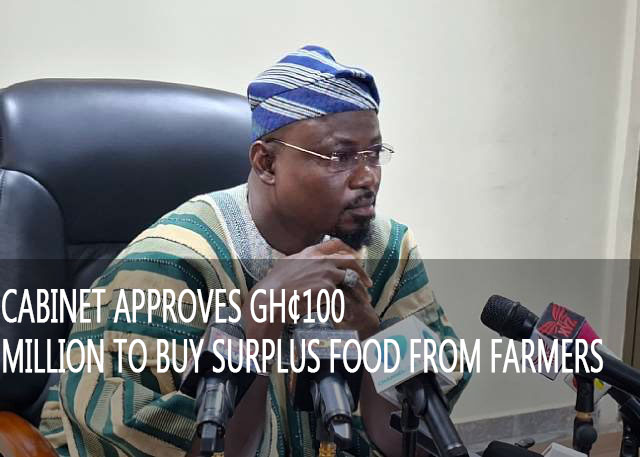In a bold move to support Ghanaian farmers and strengthen national food security, the Government of Ghana, through the Cabinet, has approved the release of an initial GH¢100 million to the National Food Buffer Stock Company (NAFCO). The funds are intended to purchase surplus food produce from farmers across the country to prevent post-harvest losses and stabilize the agricultural market.
Speaking at a press conference in Accra on Thursday, October 30, 2025, the Deputy Chief Executive of NAFCO, Mr. Osmend Amuah, confirmed the government’s decision and shared details about the ongoing food mop-up exercise.
Purpose of the GH¢100 Million Food Purchase Initiative
According to Mr. Amuah, the initiative aims to address a recurring challenge faced by farmers—the lack of reliable market access and limited storage capacity. Many farmers, especially in the Afram Plains and northern regions, have experienced post-harvest losses due to the absence of buyers and inadequate warehousing facilities.
“Farmers in the Afram Plains and the northern belt are complaining that there is no market space for them, there is no price, and because there is limited storage, some of them cannot store their produce. The potential for high post-harvest losses was huge,” he explained.
Through this programme, the government hopes to create a sustainable market for surplus farm produce and strengthen the National Food Reserve System as a buffer against future food shortages.
What the GH¢100 Million Is Being Used For
Mr. Amuah disclosed that NAFCO has already begun purchasing key staple crops across major farming zones. So far, the agency has procured 60,000 bags of rice, 120,000 bags of maize, and 10,000 bags of gari. These purchases will form part of a strategic reserve for future national food needs or emergency situations.
The government’s intervention also aligns with its broader agricultural development goals under the Food Systems Resilience Programme (FSRP)—a plan to build sustainable, climate-smart, and market-driven food systems across Ghana.
Additional GH¢100 Million Request Underway
Beyond the initial funding, the Minister for Food and Agriculture, Hon. Eric Opoku, is reportedly seeking Cabinet’s approval for an additional GH¢100 million to expand the mop-up exercise.
“The Minister for Agriculture has agreed to discuss with Cabinet the urgent need for an additional release of funding of about GH¢100 million again on an incremental basis, so that we’ll be able to mop up the additional surpluses that are on the market,” Mr. Amuah announced.
He further noted that the surplus production has been reported from various parts of the country—including the coastal, Volta, Ashanti, middle, and northern belts—and this funding will ensure that smallholder farmers directly benefit from the sales of their produce.
NAFCO Sets GH¢5 Per Kilo Floor Price for Paddy Rice
As part of the initiative, the Producer Price Determination Committee of NAFCO has established a floor price of GH¢5 per kilogram for paddy rice. This measure is designed to protect farmers from unfair pricing and exploitation by aggregators and middlemen.
“The committee has recommended a price of GH¢5 per kilogram to ensure that farmers, especially those in Fumbisi and other parts of the northern belt, receive fair compensation for their hard work,” said Mr. Amuah.
This price stabilization mechanism will not only secure farmers’ incomes but also contribute to reducing volatility in the food market.
The National Food Reserve Programme
In addition to the mop-up operation, the government has launched a National Food Reserve Programme to enhance food security and emergency preparedness. Under this plan, Ghana will aim to store 10 percent of its annual staple food consumption—equivalent to about 6.8 million tonnes.
“The National Food Reserve Programme is simple logic. In case of emergencies or famine, we should be able to set aside at least 10 percent of our annual consumption. This will mitigate food insecurity and improve national stability,” Mr. Amuah explained.
This reserve will act as a safety net during periods of scarcity, ensuring that no Ghanaian goes hungry even in the face of economic or climate shocks.
Background: Farmers’ Appeal for Government Intervention
The move follows persistent appeals from farmers across Ghana who have been struggling to sell their crops. In recent months, many took to social media to highlight their challenges, including spoilage of perishable goods, low prices, and limited access to storage facilities.
They urged the government to:
-
Purchase surplus produce through state agencies like NAFCO.
-
Establish price-setting committees for key crops.
-
Expand storage and warehousing infrastructure.
-
Introduce policies to regulate agricultural product pricing.
This latest funding approval directly addresses those concerns, providing a market lifeline for smallholder farmers.
Government’s Broader Goal: Building Food Security
The GH¢100 million funding is part of a larger government strategy to:
-
Stabilize food prices in the domestic market.
-
Reduce import dependence on staples like rice and maize.
-
Enhance rural livelihoods through guaranteed offtake schemes.
-
Promote food storage and processing industries.
By securing excess produce and creating structured demand, Ghana aims to achieve self-sufficiency in staple production and safeguard against global supply chain disruptions.
Key Highlights of the Food Purchase Initiative
| Objective | Details |
|---|---|
| Funding Approved | GH¢100 million (initial phase) |
| Additional Funding Proposed | GH¢100 million (awaiting Cabinet approval) |
| Crops Targeted | Rice, Maize, Gari, and other staples |
| Price Floor for Paddy Rice | GH¢5 per kilogram |
| Storage Goal | 10% of annual staple consumption (6.8 million tonnes) |
| Beneficiaries | Smallholder and household farmers nationwide |
| Implementing Agency | National Food Buffer Stock Company (NAFCO) |
Quotes from Officials
Osmend Amuah (Deputy CEO, NAFCO):
“This initiative is not just about buying food—it’s about protecting livelihoods and building a sustainable national reserve.”
Hon. Eric Opoku (Minister for Agriculture):
“We are determined to ensure no farmer loses their hard-earned produce due to lack of market. This is a strategic investment in Ghana’s food security.”
FAQs
1. What is the purpose of the GH¢100 million food purchase?
To buy surplus food from farmers to prevent post-harvest losses and build a national food reserve.
2. Who is implementing the programme?
The National Food Buffer Stock Company (NAFCO) under the Ministry of Food and Agriculture.
3. What crops are being purchased?
Rice, maize, gari, and other staple foods.
4. How will the price of paddy rice be determined?
NAFCO has set a minimum price of GH¢5 per kilogram to protect farmers from unfair pricing.
5. How will this affect farmers?
It will give farmers a guaranteed market for their produce, improve incomes, and reduce food waste.



https://t.me/s/REjtingTopkaZINo